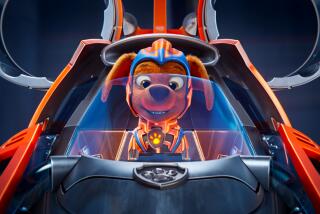MOVIE REVIEW : ‘White Fang’ Gentles the Jack London Saga
- Share via
If you’re a sucker for dog movies, as I often am, their occasional stickiness or implausibility doesn’t bother you.
Disney’s telling of Jack London’s “White Fang” (citywide) is a good example. London’s original literary material, a social parable of a wolf-dog transformed by love, isn’t negligible or cloying. But it’s been changed considerably here, made over into an archetypal, sometimes gooey tale of a boy and his dog--with a newly invented character, Jack Conroy (Ethan Hawke), whom the writers have obviously modeled on London himself. Despite this, the movie tends to work on its own terms and hits its marks.
The new “Jack” is a gawky, seraphic-looking late-adolescent, who always seems to have his mouth open, gaping in wonderment at the Northern wilderness around him, squabbling lovably with his crusty mentors: Klaus Maria Brandauer, implausibly cast as the Scandinavian Alex Larson and Seymour Cassel as a Klondike buffoon.
After he is orphaned, by Jack’s friend, the dog passes through many of the same adventures as London’s Fang: living in an Indian camp with trapper Grey Beaver (Pius Savage), getting brutal mistreatment from maniacal dogfight handler Beauty Smith (James Remar). But the movie splits its plot: intercutting together Fang’s and Jack’s adventures.
“White Fang” all but revels in its full-blown human-animal bonding romanticism. Perhaps because executive producers Andrew Bergman and Michael Lobell usually specialize in comedy, they’re almost able to slide past the absurdities: the musical comedy Yukon camp, the numerous coincidences.
The film is paced like a comedy--briskly--and director Randal Kleiser shows a big, expansive, sunny temperament. A variable filmmaker, Kleiser does some of his best work here. The town scenes are abuzz with amusingly raffish activity, the actors--especially Brandauer and Cassel--play their archetypal roles with cheerful or morbid conviction; the wilderness scenes are spacious, exciting. Cinematographer Tony Pierce-Roberts, of the recent Merchant-Ivory films, brings unforced lyricism to the Alaskan vistas: the snow-capped cliffs, icy lakes and crisp forest glades.
It’s obvious that, to some degree, this “White Fang” has been influenced by movies like “The Black Stallion,” “Never Cry Wolf” and “The Bear”: Bart the Bear even turns in a cameo appearance as a surly marauder from whom Fang rescues Jack.
It’s also obvious that the sensibility behind the story is different. London, despite his pro-animal stance, painted Fang’s world as “a chaos of gluttony and slaughter,” ruled by the credo “Eat or be eaten,” and he probably meant to extend that indictment to parts of “civilized” society as well. The movie, conversely, is more a flower child’s “White Fang”: blissed-out, generous, angry at man’s assaults on nature.
London, writing before wolves were driven into near-extinction, wasn’t chary of portraying a savage side. The moviemakers use his blood-chilling opening--successive wolf-pack assaults on an isolated man and dog team--and then, at the end, run a disclaimer from the Defenders of Wildlife. London’s Fang was, fundamentally, a loner and a killer; the movie Fang is a big, friendly dog, temporarily derailed into the fight game by snarling villains.
That makes this “White Fang,” (rated PG) rather oversunny, overaffirmative, primarily a movie for children. But I liked it anyway, despite the softened tone, the coincidences, despite Hawke’s constantly gaping mouth. There is something archetypal and pure about these boy-and-dog, or girl-and-dog, stories that a bit of conviction, some good actors and lots of gorgeous scenery can often redeem, sometimes make almost irresistible. In the best moments of “White Fang,” that’s what happens.
More to Read
Only good movies
Get the Indie Focus newsletter, Mark Olsen's weekly guide to the world of cinema.
You may occasionally receive promotional content from the Los Angeles Times.









